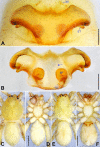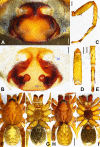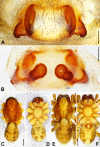A survey of ctenid spiders (Araneae, Ctenidae) from Xishuangbanna Tropical Botanical Garden, Yunnan, China
- PMID: 36761608
- PMCID: PMC9848462
- DOI: 10.3897/BDJ.10.e87597
A survey of ctenid spiders (Araneae, Ctenidae) from Xishuangbanna Tropical Botanical Garden, Yunnan, China
Abstract
Background: Amauropelma Raven, Stumkat & Gray, 2001 currently contains 24 species. It is distributed in Australia, India, Indonesia, Laos and Malaysia. This genus has not been found in China. Ctenus Walckenaer, 1805 comprises 213 known species. This genus is distributed worldwide. Currently, only two species, Ctenuslishuqiang Jäger, 2012 and Ctenusyaeyamensis Yoshida, 1998 are known to occur in China.
New information: Three new species of ctenid spiders are described from Xishuangbanna Tropical Botanical Garden in Yunnan Province, China: Amauropelmayunnan sp. nov., Ctenusbanna sp. nov. and Ctenusyulin sp. nov. Amauropelma and Ctenusrobustus Thorell, 1897 are reported from China for the first time.
Keywords: biodiversity; morphology; new record; new species; taxonomy.
Chang Chu, Ying Lu, Zhiyuan Yao, Shuqiang Li.
Figures







References
-
- Davies V T. The huntsman spiders Heteropoda Latreille and Yiinthi gen. nov. (Araneae: Heteropodidae) in Australia. Memoirs of the Queensland Museum. 1994;35(1):75–122.
-
- Höfer H, Brescovit A D, Gasnier T. The wandering spiders of the genus Ctenus (Ctenidae, Araneae) of Reserva Ducke, a rainforest reserve in central Amazonia. Andrias. 1994;13:81–98.
-
- Jäger Peter. Asian species of the genera Anahita Karsch 1879, Ctenus Walckenaer 1805 and Amauropelma Raven, Stumkat & Gray 2001 (Arachnida: Araneae: Ctenidae). Zootaxa. 2012;3429:1–63. doi: 10.11646/zootaxa.3429.1.1. - DOI
-
- Jocqué R, Dippenaar-Schoeman AS. Spider families of the world. Musée Royal de l'Afrique Central Tervuren, 336 pp 2006
-
- Khmelik V V, Kozub D, Glazunov A. Helicon Focus. Version 3.10.3. 2005. https://www.heliconsoft.com/heliconsoft-products/helicon-focus/ https://www.heliconsoft.com/heliconsoft-products/helicon-focus/
LinkOut - more resources
Full Text Sources
